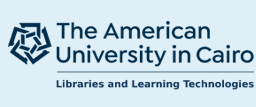-

Introduction (Environmental Threats in Egypt: Perceptions and Actions)
Salwa Sharawi Gomaa
[abstract not provided]
-

Supplement: Directory of Egyptian Environmental Non-Governmental Organizations
Salwa Sharawi Gomaa
[abstract not provided]
-

Pollution and People in Cairo
Nicholas S. Hopkins, Sohair Mehanna, Tamer Abdelkader, Noha Abu Gazia, Samer El-Karanshawy, and Inas Tewfik
[abstract not provided]
-

Human Rights in the Middle East: An Overview of the Last Decade
Hanny Megally
"First presented at the 1994 Cairo Papers Annual Symposium"
-

US Foreign Policy and Human Rights in Egypt
Stephanie Ann Mulica
"First presented at the 1994 Cairo Papers Annual Symposium"
-

Cultural Heritage as Environment: Area Conservation in Cairo's Historic Zone
John Rodenbeck
[abstract not provided]
-

The Roots of Turmoil in the Egyptian Organization for Human Rights: Dynamics of Civil Institution-Building in Egypt
Mohamed El Sayed Said
"First presented at the 1994 Cairo Papers Annual Symposium"
-

Human Rights in Egypt: The Cause, the Movement, and the Dilemma
Hani Shukrallah
"First presented at the 1994 Cairo Papers Annual Symposium"
-

Introduction: Dealing with Human Rights in the Arab World
Dan Tschirgi
"First presented at the 1994 Cairo Papers Annual Symposium"
-

The Rationale for Structural Adjustment: A Layman's Guide
Marcelo M. Giugale
[abstract not provided]
-

Egypt's Program for Stabilization and Structural Adjustment: An Assessment
Hans Löfgren
[abstract not provided]
-

Introduction (the Economics and Politics of Structural Adjustment in Egypt)
Hans Löfgren
[abstract not provided]
-

The Politics of Adjustment in Africa with Special Reference to Egypt
Trevor Parfitt
[abstract not provided]
-

The Nationalization of the IMF: The Nature and Evolution of the Official Discourse on Economic Reform in Egypt (1987-1991)
Mourad Magdi Wahba
[abstract not provided]
-

Scarce Resources, Perception of Risk, and Collective Action
Nicholas S. Hopkins
[abstract not provided]
-

Denial in the Decisive Decade: Towards Intervention and Common Action
Sandra Postel
[abstract not provided]
Printing is not supported at the primary Gallery Thumbnail page. Please first navigate to a specific Image before printing.










